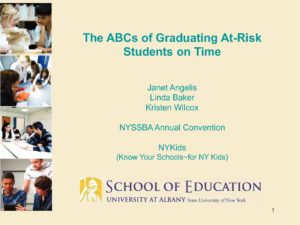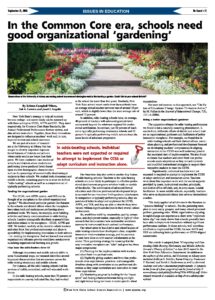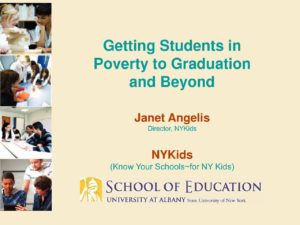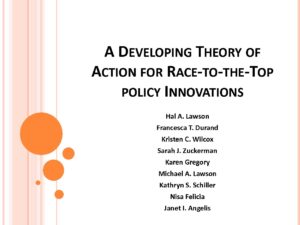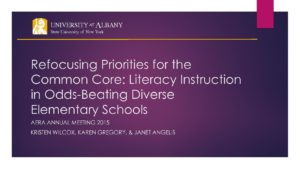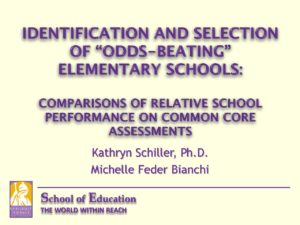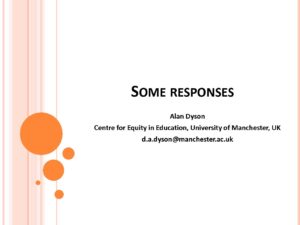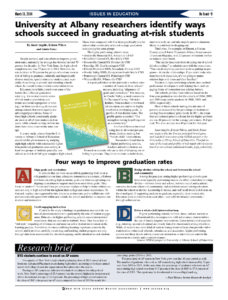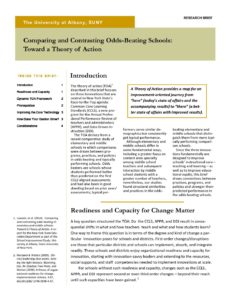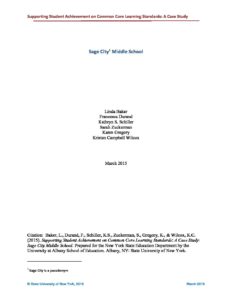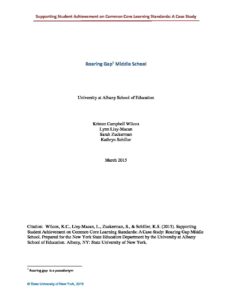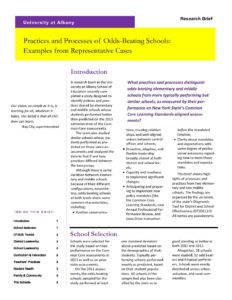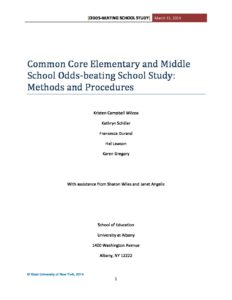Publication Year: 2015
This presentation identifies the school practices and polices found in elementary and middle schools whose students exceeded performance expectations on the 2012-13 New York State assessments, which were the first aligned with the Common Core Standards.
This presentation identifies the school practices and polices found in elementary and middle schools whose students exceeded performance expectations on the 2012-13 New York State assessments, which were the first aligned with the Common Core Standards.
This presentation identifies the school practices and polices found in elementary and middle schools whose students exceeded performance expectations on the 2012-13 New York State assessments, which were the first aligned with the Common Core Standards.
This presentation identifies the school practices and polices found in elementary and middle schools whose students exceeded performance expectations on the 2012-13 New York State assessments, which were the first aligned with the Common Core Standards.
This presentation describes the COMPASS process: (1) COMPare practices to higher performers; (2) Assess priorities; (3) Select potential levers to improve; (4) Set SMART goals. And then AIM process: (1) Action planning; (2) Implementation; and (3) Monitoring progress.
This presentation describes the COMPASS process: (1) COMPare practices to higher performers; (2) Assess priorities; (3) Select potential levers to improve; (4) Set SMART goals. And then AIM process: (1) Action planning; (2) Implementation; and (3) Monitoring progress.
This presentation presents findings that in high schools with higher than expected graduation rates, educators are looking beyond graduation to students’ post-secondary needs, and meeting those needs with clear goals, strong relationships, individual attention, and flexibility.
This presentation presents findings that in high schools with higher than expected graduation rates, educators are looking beyond graduation to students’ post-secondary needs, and meeting those needs with clear goals, strong relationships, individual attention, and flexibility.
This article discusses important organizational features of districts and schools whose early results on the Common Core Assessments are better than their peer schools.
This article discusses important organizational features of districts and schools whose early results on the Common Core Assessments are better than their peer schools. The Common Core State Standards, Annual Professional Performance Review system and Data-Driven Instruction can be thought of as transplants to the school organizational “garden.” Findings suggest particular garden-like features in the schools and district offices where the transplants have taken hold and students are performing above predicted levels.
This presentation presents findings that in high schools with higher than expected graduation rates, educators are looking beyond graduation to students’ post-secondary needs, and meeting those needs with clear goals, strong relationships, individual attention, and flexibility.
This presentation presents findings that in high schools with higher than expected graduation rates, educators are looking beyond graduation to students’ post-secondary needs, and meeting those needs with clear goals, strong relationships, individual attention, and flexibility.
This presentation presents on a study that investigated school leadership team participants’ perceptions of an intervention called COMPASS. COMPASS engages teams from different schools and districts in activities to identify strengths, weaknesses, and priorities then engage in an inquiry cycle of implementing action plans, gathering data and interpreting evidence in order to reach targeted goals.
This qualitative multiple case study contributes to the growing body of translational research that
seeks to better understand what is needed to develop capacities for evidence-guided continuous
improvement in P-12 settings. The study investigated school leadership team participants’
perceptions of an intervention called COMPASS. COMPASS engages teams from different
schools and districts in activities to identify strengths, weaknesses, and priorities then engage in
an inquiry cycle of implementing action plans, gathering data and interpreting evidence in order
to reach targeted goals. Two-hundred and twenty-eight district and school leaders and
instructional staff from 36 school teams provided reflections on the intervention revealing the
majority reported increases in competence in all dimensions of evidence-guided decision
making, from priority and goal setting to identifying potential research-based levers to
improvement as well as increased capacities for school- and district-wide action planning and
progress monitoring. Observation field notes, documentary evidence, and interviews with school
leaders also indicate that the process fundamentally shifts educators’ focus on systemic changes
to achieve system-wide targeted goals. Implications for theory, future research, and
considerations for those interested in university/P-12 partnerships for continuous improvement
are discussed.
Presentation of the findings from a comparative study of New York State schools designed to investigate implementation of Common Core Learning Standards (CCLS) and the Annual Professional Performance Review (APPR) as they relate to student performance outcomes on CCLS-aligned assessments.
Presentation of the findings from a comparative study of New York State schools designed to investigate implementation of Common Core Learning Standards (CCLS) and the Annual Professional Performance Review (APPR) as they relate to student performance outcomes on CCLS-aligned assessments.
Presentation of the findings from a comparative study of New York State schools designed to investigate implementation of Common Core Learning Standards (CCLS) and the Annual Professional Performance Review (APPR) as they relate to student performance outcomes on CCLS-aligned assessments.
Presentation of the findings from a comparative study of New York State schools designed to investigate implementation of Common Core Learning Standards (CCLS) and the Annual Professional Performance Review (APPR) as they relate to student performance outcomes on CCLS-aligned assessments.
Presentation of the findings from a comparative study of New York State schools designed to investigate implementation of Common Core Learning Standards (CCLS) and the Annual Professional Performance Review (APPR) as they relate to student performance outcomes on CCLS-aligned assessments.
Presentation of the findings from a comparative study of New York State schools designed to investigate implementation of Common Core Learning Standards (CCLS) and the Annual Professional Performance Review (APPR) as they relate to student performance outcomes on CCLS-aligned assessments.
Presentation of the findings from a comparative study of New York State schools designed to investigate implementation of Common Core Learning Standards (CCLS) and the Annual Professional Performance Review (APPR) as they relate to student performance outcomes on CCLS-aligned assessments.
Presentation of the findings from a comparative study of New York State schools designed to investigate implementation of Common Core Learning Standards (CCLS) and the Annual Professional Performance Review (APPR) as they relate to student performance outcomes on CCLS-aligned assessments.
Presentation of the findings from a comparative study of New York State schools designed to investigate implementation of Common Core Learning Standards (CCLS) and the Annual Professional Performance Review (APPR) as they relate to student performance outcomes on CCLS-aligned assessments.
Presentation of the findings from a comparative study of New York State schools designed to investigate implementation of Common Core Learning Standards (CCLS) and the Annual Professional Performance Review (APPR) as they relate to student performance outcomes on CCLS-aligned assessments.
Presentation of the findings from a comparative study of New York State schools designed to investigate implementation of Common Core Learning Standards (CCLS) and the Annual Professional Performance Review (APPR) as they relate to student performance outcomes on CCLS-aligned assessments.
Presentation of the findings from a comparative study of New York State schools designed to investigate implementation of Common Core Learning Standards (CCLS) and the Annual Professional Performance Review (APPR) as they relate to student performance outcomes on CCLS-aligned assessments.
In a new study, a team from the University at Albany’s School of Education examined high school completion.
In a new study, a team from the University at Albany’s School of Education examined high school completion by studying eight high schools with consistently higher than predicted graduation rates among at least two groups of students generally considered at risk of failing to complete high school. These were compared with five demographically similar schools that consistently achieved average graduation rates among the same groups.
This article discusses findings across studies of higher performing schools since 2005.
Since 2005, NYKids has conducted six such studies spanning elementary through high school, with some looking at specific instructional contexts (e.g. science classrooms) and others at particular groups of students (ethnic and linguistic minority and special needs). NYKids have found that the higher-performing schools in each study share some common characteristics that distinguish them from schools with typical performance. Across all the studies, NYKids found that in the higher performers, educators collaboratively use data to drive decisions about curriculum and instruction with the goal of ensuring that every student can and will learn; in addition, they take the stance that “poverty is no excuse” for poor student performance.
This presentation presents findings on studies examining the practices of schools that do better than expected with high-poverty populations. Key findings include: (1) a vision of success that includes high poverty students achieving beyond predicted levels; (2) collaboration and shared responsibility; and (3) decision making based on a variety of evidence.
This presentation presents findings on studies examining the practices of schools that do better than expected with high-poverty populations. Key findings include: (1) a vision of success that includes high poverty students achieving beyond predicted levels; (2) collaboration and shared responsibility; and (3) decision making based on a variety of evidence.
A systematic examination of the ways a variety of schools have approached and responded to the Common Core Learning Standards (CCLS) and the Annual Professional Performance Review (APPR) systems, both part of the Race to the Top reform agenda.
The Common Core Odds-Beating Studies were developed in collaboration between a team of researchers at the University at Albany and the New York State Education Department. The study began in the recognition that there was a need for research investigating the process and practices in schools with relatively better outcomes on the Common Core-aligned assessments first implemented in the state in the 2011-2012 school year. At the time of this study, there had been no systematic examinations of the ways a variety of schools have approached and responded to the Common Core Learning Standards (CCLS) and the Annual Professional Performance Review (APPR) systems, both part of the Race to the Top reform agenda.
This case is one part of a comparative study of New York State middle schools designed to investigate implementation of Common Core Learning Standards (CCLS) and the Annual Professional Performance Review (APPR) as they relate to student performance outcomes on CCLS-aligned assessments. The study sample included both odds-beating and typically performing schools.
The Common Core Odds-Beating Studies were developed in collaboration between a team of researchers at the University at Albany and the New York State Education Department. The study began in the recognition that there was a need for research investigating the process and practices in schools with relatively better outcomes on the Common Core-aligned assessments first implemented in the state in the 2011-2012 school year. At the time of this study, there had been no systematic examinations of the ways a variety of schools have approached and responded to the Common Core Learning Standards (CCLS) and the Annual Professional Performance Review (APPR) systems, both part of the Race to the Top reform agenda.
This case is one part of a comparative study of New York State middle schools designed to investigate implementation of Common Core Learning Standards (CCLS) and the Annual Professional Performance Review (APPR) as they relate to student performance outcomes on CCLS-aligned assessments. The study sample included both odds-beating and typically performing schools.
The Common Core Odds-Beating Studies were developed in collaboration between a team of researchers at the University at Albany and the New York State Education Department. The study began in the recognition that there was a need for research investigating the process and practices in schools with relatively better outcomes on the Common Core-aligned assessments first implemented in the state in the 2011-2012 school year. At the time of this study, there had been no systematic examinations of the ways a variety of schools have approached and responded to the Common Core Learning Standards (CCLS) and the Annual Professional Performance Review (APPR) systems, both part of the Race to the Top reform agenda.
A systematic examination of the ways a variety of schools have approached and responded to the Common Core Learning Standards (CCLS) and the Annual Professional Performance Review (APPR) systems, both part of the Race to the Top reform agenda.
The Common Core Odds-Beating Studies were developed in collaboration between a team of researchers at the University at Albany and the New York State Education Department. The study began in the recognition that there was a need for research investigating the process and practices in schools with relatively better outcomes on the Common Core-aligned assessments first implemented in the state in the 2011-2012 school year. At the time of this study, there had been no systematic examinations of the ways a variety of schools have approached and responded to the Common Core Learning Standards (CCLS) and the Annual Professional Performance Review (APPR) systems, both part of the Race to the Top reform agenda.
A systematic examination of the ways a variety of schools have approached and responded to the Common Core Learning Standards (CCLS) and the Annual Professional Performance Review (APPR) systems, both part of the Race to the Top reform agenda.
The Common Core Odds-Beating Studies were developed in collaboration between a team of researchers at the University at Albany and the New York State Education Department. The study began in the recognition that there was a need for research investigating the process and practices in schools with relatively better outcomes on the Common Core-aligned assessments first implemented in the state in the 2011-2012 school year. At the time of this study, there had been no systematic examinations of the ways a variety of schools have approached and responded to the Common Core Learning Standards (CCLS) and the Annual Professional Performance Review (APPR) systems, both part of the Race to the Top reform agenda.
A systematic examination of the ways a variety of schools have approached and responded to the Common Core Learning Standards (CCLS) and the Annual Professional Performance Review (APPR) systems, both part of the Race to the Top reform agenda.
The Common Core Odds-Beating Studies were developed in collaboration between a team of researchers at the University at Albany and the New York State Education Department. The study began in the recognition that there was a need for research investigating the process and practices in schools with relatively better outcomes on the Common Core-aligned assessments first implemented in the state in the 2011-2012 school year. At the time of this study, there had been no systematic examinations of the ways a variety of schools have approached and responded to the Common Core Learning Standards (CCLS) and the Annual Professional Performance Review (APPR) systems, both part of the Race to the Top reform agenda.
A systematic examination of the ways a variety of schools have approached and responded to the Common Core Learning Standards (CCLS) and the Annual Professional Performance Review (APPR) systems, both part of the Race to the Top reform agenda.
The Common Core Odds-Beating Studies were developed in collaboration between a team of researchers at the University at Albany and the New York State Education Department. The study began in the recognition that there was a need for research investigating the process and practices in schools with relatively better outcomes on the Common Core-aligned assessments first implemented in the state in the 2011-2012 school year. At the time of this study, there had been no systematic examinations of the ways a variety of schools have approached and responded to the Common Core Learning Standards (CCLS) and the Annual Professional Performance Review (APPR) systems, both part of the Race to the Top reform agenda.




